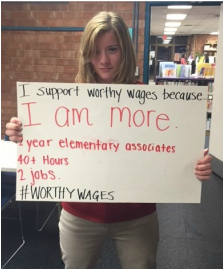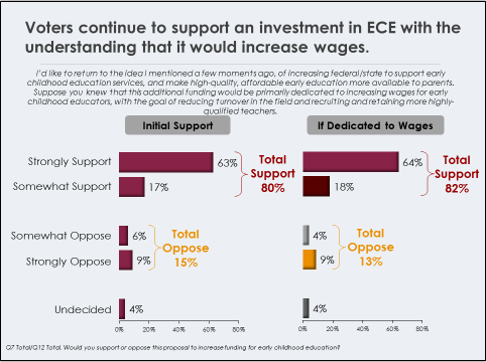FIRSTHAND FOOTAGE OF WHAT IT IS LIKE TO JOB
SHADOW....
News and Resources around Early Childhood Education Compensation:Scroll through the resources above to find articles, data, press and media related to compensation in the early childhood profession.
|
|
|
|
What is Worthy Wage Day?Worthy Wage Day began in 1992 as a group of early childhood teachers organized at a grassroots level in order to advocate for higher wages. Unfortunately, the average wages for early childhood professionals today hasn't changed much since 1992, so we are still on the battlefield to raise public awareness about the problems these teachers face. Worthy Wage Day is designed to have pockets of people, such as policy makers, community members, stakeholders, and decision makers "job shadow" in an early childhood classroom for a morning. On May 1st, after their experience in the classrooms, they meet to begin the conversation around some next steps they are ready and willing to take. They also receive their paychecks, which for four hours of work will average about $30.00...don't forget to pay taxes out of that, too!
The link above to the Worthy Wage footage is from Greensboro, NC's Worthy Wage Day, 2015. |
|
IF YOU DON'T KNOW YOUR PAST YOU ARE DOOMED TO REPEAT IT |
|
Where we are going...In order to initiate change, we have to advocate for ourselves as early childhood professionals, and for those whom we know, love, and trust with our children's future. There are few, if any, policies in North Carolina supporting the pay for early childhood professionals. We know that parents cannot afford to pay more, as tuition rates have steadily increased over time. However, the best teachers can't afford to stay. If we are buying into the idea of getting our children ready to enter the school system at age 5, we have to buy in to supporting early childhood wages, as well.
|
|
Data courtesy of National Association for the Education of Young Children, Executive Summary: Early Childhood Educators, Advancing the Profession (2015).
HOW DO LOW WAGES DIRECTLY AFFECT CHILDREN?
One would argue that when a child is stressed, he or she will show it in the classroom, so we should also agree that when a teacher is stressed that it will affect the classroom, as well.
We have a tendency to think of quality as materials, a nice environment, and the ability to achieve all of the standards set forth by the governing systems over child care. The one component that is harder to capture, is teacher-child interactions. We could set up a room with an endless supply of toys and books, counters that are sanitized properly, and diapers that are regularly checked, however without an engaged, loving, and supportive teacher involved we are leaving our children to chance.
When looking at the impact of teacher disposition upon quality, Whitebook, Phillips, & Howes (2014) looked at the commonalities among early childhood workers in order to connect the stressors to a source. Of the early childhood educators that are also parents, 57% worry about simply having food on their table (Whitebook, Phillips, & Howes, 2014). Stress levels directly affect the ability of a teacher to provide high quality care in the classroom. An early childhood teacher who is struggling to choose between keeping on the power or taking their sick child to see a doctor cannot possibly provide the quality of care that we expect in the classroom. It is time for us to stand up and ask for support.
We have a tendency to think of quality as materials, a nice environment, and the ability to achieve all of the standards set forth by the governing systems over child care. The one component that is harder to capture, is teacher-child interactions. We could set up a room with an endless supply of toys and books, counters that are sanitized properly, and diapers that are regularly checked, however without an engaged, loving, and supportive teacher involved we are leaving our children to chance.
When looking at the impact of teacher disposition upon quality, Whitebook, Phillips, & Howes (2014) looked at the commonalities among early childhood workers in order to connect the stressors to a source. Of the early childhood educators that are also parents, 57% worry about simply having food on their table (Whitebook, Phillips, & Howes, 2014). Stress levels directly affect the ability of a teacher to provide high quality care in the classroom. An early childhood teacher who is struggling to choose between keeping on the power or taking their sick child to see a doctor cannot possibly provide the quality of care that we expect in the classroom. It is time for us to stand up and ask for support.
References
Whitebook, M., Phillips, D., & Howes, C. (2014). Worthy work, STILL unlivable wages: The early childhood workforce 25 years after the National Child Care Staffing Study. Berkeley: Center for the Study of Child Care Employment, University of California, Berkeley.
Whitebook, M. (1999). Child care workers: High demand, low wages. Annals of the American Academy of Political and Social Science, 563(1), 146-161.
Whitebook, M. (1999). Child care workers: High demand, low wages. Annals of the American Academy of Political and Social Science, 563(1), 146-161.




